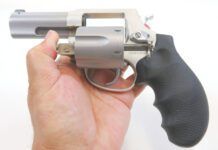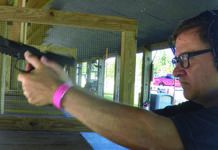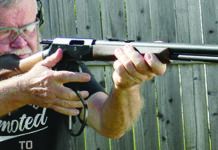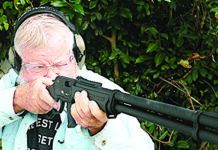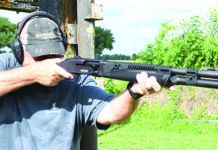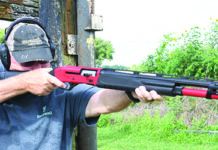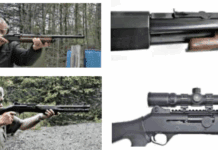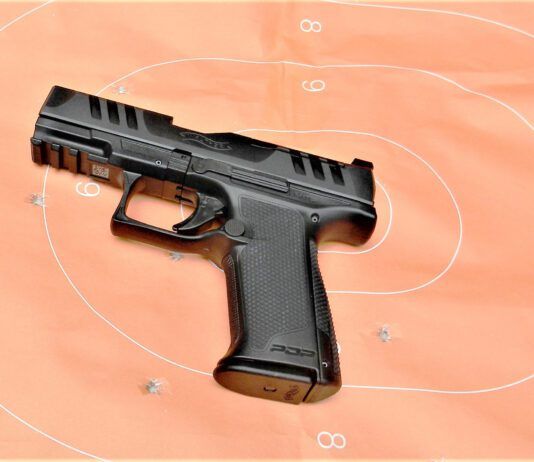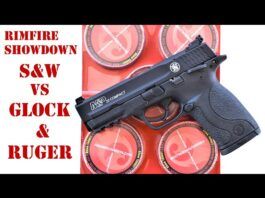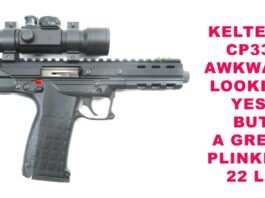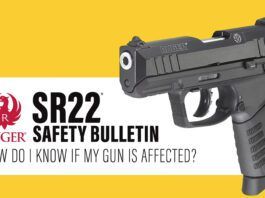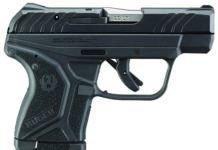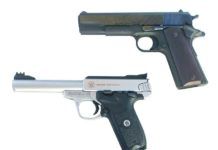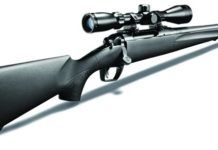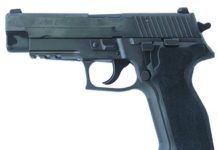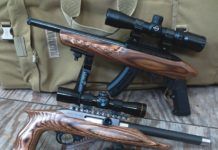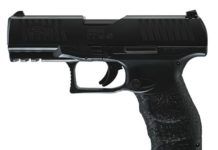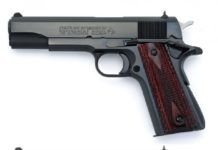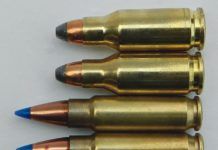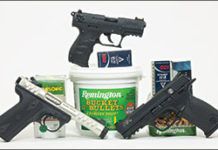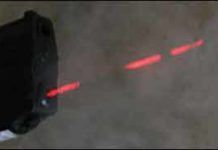Ruger LCP II Lite Rack 13705 22 LR
Glock G44 Compact 11921822 22 LR
22-Caliber Handgun Shoot-Out: Smith, TacSol, Beretta, Colt
In this installment, we are looking at some of the best 22-caliber pistols for all-around target shooting and training for marksmanship and personal-defense practice, with an emphasis on viability for personal-defense training. Some handguns are just fine for general plinking, but the modern shooter demands the ability to train with combat lights or even a red-dot sight. All 22s do not allow this type of versatility. Let's look at four 22-caliber handguns and see how they stack up as modern trainers.
The 22 self-loading handgun is a great firearm that every handgunner should own at least one of. The 22 is a great trainer, and it is also a good small-game handgun, and it is even useful in some forms of competition. The absence of recoil and muzzle report compared to centerfire handguns is often touted, but recoil and muzzle blast are there, simply in easily manageable portions. The shooter is free to concentrate on trigger press, sight picture, sight alignment, and grip. Practice in offhand fire, combat practice, firing for extreme accuracy from a solid rest, clearing malfunctions and hunting game are just some of the practice that may be accomplished with the 22 pistol. For small-game hunting, excellent accuracy is demanded. For combat practice—and this is an important point—the handgun should be similar to the centerfire defense gun in accuracy. In that manner, the shooter isn't given a false sense of security by a 22 that is much more accurate than the 9mm or 45 they use for personal defense. When practicing with the 22, the serious shooter should use the same grip and trigger press that he or she uses when mastering the 9mm or 45. Using a lighter grip or shooting fast just because the 22 is so controllable doesn't cross over into personal defense skills; it is simply shooting for fun.
We collected two 22-caliber handguns and two 22-caliber conversion units for comparison. One of the handguns is a new model and the other, a relatively new and often overlooked pistol. The firearms tested included the Smith & Wesson Victory 22, Beretta Neos 22, Tactical Solutions' Glock conversion unit, and a Colt 22 Ace conversion unit.
308 Winchester Bolt-Actions: Remingtons M783 Rifle Wins
Among the most useful, versatile, and powerful all-round sporting rifles is the 308 Winchester bolt action. These rifles are accurate, reliable, and can take on small to big game in many hunting conditions. When married with a good optic and in competent hands, they are well suited to take a 200-pound target at 200 yards and beyond, as a rule of thumb. The chambering is a joy to use and fire, compared to hard-kicking magnums, and offers plenty of recreational value. The bolt-action 308 is also a useful tactical rifle in many situations, and the round is widely used by law enforcement across the country.
We recently took a hard look at four bolt-action rifles chambered in 308 Winchester, with a special emphasis on looking for affordable options. So we chose two used rifles and one lower-cost new rifle and compared them to a rifle in a higher price range to ensure we weren't missing something that more dollars could provide. These rifles included the now-discontinued Mossberg ATR, the Remington 783, the Remington 700 SPS, and the Savage Axis. In this quartet, we shot three loads for accuracy testing and another load in offhand fire to gauge the accuracy of the rifles. As it turns out, the economy combination rifle that comes from the factory with a bore-sighted scope is a good deal. Though the Remington 783 was the most accurate rifle, we also liked the Remington 700 SPS a lot. Overall, however, the Savage Axis combination seems a best buy. Let's look hard at these rifles and delve into why we made these choices and to see if you agree with our assessments.
2016 Guns & Gear Top Picks
Toward the end of each year, I survey the work R.K. Campbell, Roger Eckstine, Austin Miller, Robert Sadowski, David Tannahill, Tracey Taylor, John Taylor, Rafael Urista, and Ralph Winingham have done in Gun Tests, with an eye toward selecting guns, accessories, and ammunition the magazine's testers have endorsed. From these evaluations I pick the best from a full year's worth of tests and distill recommendations for readers, who often use them as shopping guides. These choices are a mixture of our original tests and other information I've compiled during the year. After we roll high-rated test products into long-term testing, I keep tabs on how those guns do, and if the firearms and accessories continue performing well, then I have confidence including them in this wrap-up.
22 LR Pistols Based on Rifles From Ruger, MRI, and Mossberg
The Ruger 10/22 rifle is the most customizable semi-automatic rimfire rifle on the market. In fact, some manufacturers have taken 10/22 rifles and radically converted them to make highly accurate target rifles or built in internally-suppressed barrels for low-noise shooting. Some have molded shells to make the 10/22 look like an M1 Carbine or a Thompson submachine gun, while others have made them into pistols, as this test recognizes. By reconfiguring the buttstock into a pistol grip and reducing the barrel length, the same receiver is used to create an entirely different class of pistol. We wanted to take a look at these pistols, two derived from a Ruger 10/22 and one from the Mossberg 702 Plinkster, to see what they offered other than just an abbreviated variant of a long gun.
We secured a slightly used model of Magnum Research's Picuda that was mounted with a fixed 4x-power Leupold scope (#58750; $440). Ruger debuted its own 10/22 pistol in 2008, calling it the Charger, and ended production in 2012 — only to reintroduce a revised variant in 2015. The original Ruger Charger was very similar in appearance to the Magnum Research Picuda, while this new Ruger 22 Charger we tested is more refined, with plenty of features to like. Mossberg's 715P pistol came out in 2014. While the Magnum Research and Ruger are similar since they share a similar operating system, their design appeals to shooters and hunters who desire precision shooting, while the Mossberg is made to satisfy plinkers.
All three pistols use a simple blowback mechanism that is the same mechanism as used in the rifle. The pistols look ungainly since they use the same receivers as the rifles. The barrels, however, are cut down in all three models. The Magnum Research and Ruger reconfigured the rifle stock to a pistol grip sans buttstock. Though the Ruger and Magnum Research grip/stock were similar, the Ruger offered more options, so a shooter can set up the pistol to suit his shooting needs.
To make the 715P, Mossberg basically takes a 702 barreled action and sandwiches it between two polymer halves to give the pistol the appearance of an AR-15 pistol. The similarity to an AR pistol is only cosmetic, as the 715P functions just like the 702. Consider it a sheep in wolves' clothing. The Charger 22 and Picuda come optics ready, requiring a user to invest in a optic and rings. A Weaver rail is built into the Magnum Research pistol, while the Ruger comes with a Picatinny rail screwed into to the receiver. We mounted a BSA Edge 2-7x32mm pistol scope (#PS27X32; $140) on the Ruger. The Mossberg has open sights and is good to go out of the box, but to keep the playing field relatively level we added a CenterPoint Tactical 30mm Enclosed Reflex red-dot optic (Model #72601; $30). Mossberg offers a red-dot sight as an option on other 715P models. The CenterPoint optic co-witnessed with the top quarter of the iron sights on the 715P, which we liked. The rail on the Mossberg looks like a Picatinny/Weaver style, but it is not, as we discovered when mounting the CenterPoint Tactical red dot. Here's more about what we discovered about these rimfire rifles converted to pistols.
Walther Makes First 45 ACP Pistol
Walther's new PPQ in 45 ACP is the first true production Walther in that chambering in the company's history, Walther says. The gun is equipped with the Carl Walther quick defense trigger, traditional front and rear slide serrations, and ambidextrous controls like other PPQs. The PPQ 45 Auto will hit the market and be available in retail stores on October 1, 2015.
Cyndi Flannigan, Walther Arms' vice president of sales and marketing, says of the new pistol, "This new caliber and product offering is a benchmark for Walther and the PPQ. We have built it to the same exact German standards that have made this model so well received, and it is a superior choice for home defense and personal protection." We'll soon see about that.
Colt Versus Colt 45s: Series 70 Competes Against the 1991A1
When other makers put market pressure on Colt by introducing a bevy of inexpensive 1911A1 handguns, Colt responded with the 1991A1, replacing the expensive Colt high-polish bluing with a matte finish. Walnut grips were deleted in favor of plastic or rubber, although recent Colt 1991A1 production features good-quality wood-grip panels. Features these more affordable 1991A1-Colt pistols kept were the flat mainspring housing and long style trigger of the original 1911 handgun. The usually accepted justification for having a flat mainspring housing is that it is easier to fit a custom-grade beavertail safety. The 1991A1 also featured a scalloped ejection port and sights that are an improvement over GI-model handguns. There was no full-length guide rod, so the pistol was easily field stripped. In the eyes of many, Colt successfully turned out a basic 1991A1 that was affordable for those who would prefer to own a Colt rather than other brands.
However, there was a bone of contention concerning the 1991A1. If a company is going to make institutional LE or other agency sales in this century, the pistol must have a firing-pin lock or drop safety. The Series 80 firing-pin block used in the 1991A1 adds four parts in comparison to the Series 70. The parts are the frame-mounted trigger-bar lever and plunger and the slide-mounted firing-pin plunger and driving spring. Simplicity must be better for reliability, some said. The firing-pin block keeps the firing pin in place until the trigger reaches its rearward travel maximum and releases the firing-pin block and the firing pin. Also, shooters soon learned that care must be taken in disassembly and reassembly with this design so that the plunger is not damaged.
Why was the firing-pin block introduced? If the 1911 handgun were dropped on the muzzle from a sufficient height, the inertia of the firing pin could take a run forward against spring pressure and crack the primer, firing the pistol. This problem is not unique to the 1911; many pistol designs have been updated with firing-pin blocks. Some makers solve the problem with a lightweight firing pin and heavy-duty firing-pin spring. In fact, Para Ordnance (now Para USA) and SIG use the Series 80 firing-pin lock by license. Once Beretta and SIG incorporated the firing-pin block in production, competitors had to follow the same path in order to compete in the law-enforcement market. Even though the majority of accidental discharges are negligent rather than accidental and are caused by shooter error, the firing-pin block is here to stay in the 1991A1. And therein was the problem for many Colt fans.
In short, they feel that Colt ruined the trigger action by adding the drop safety, and that the resulting Series 80 designation was inferior to the Series 70. Others felt that the assembly could lead to problems if it malfunctioned. The fact is, a Series 80 design may malfunction if a trigger job isn't done correctly or if a lightweight trigger is added to the pistol and not adjusted correctly. In any case, many Colt shooters believe the Series 70 is a better set-up than the Series 80 design.
The way we see it, the only way to determine if the Series 80 design is inferior to the original Series 70 design is to shoot them side by side with a team of testers who love to nitpick. So we acquired a high-grade current-production Colt that is similar to the original Series 70 — that is, a pistol with good finish and excellent fitting but without the firing-pin block — and shot it against a 1991A1 Series 80 pistol. Each pistol was supplied with two Colt magazines. We normally use a good supply of 1911 magazines during testing, but to thoroughly proof each pistol, only Colt factory magazines, as supplied with the pistol, were used. Most important, there were no malfunctions of any type with either handgun.
So, beyond that, is it worth it for Colt fans to go to the gun show, cash in hand, searching for a Series 70 pistol, or for non-Colt shooters, a similar 1911 handgun without the firing-pin block? Side-by-side shooting determined just how great an advantage, if any, the Series 70 has over the 1991A1 with its Series 80 internals. Here's what we found:
22-Caliber Centerfire Self-Loader Shoot-out: FNH Vs. Rock Island
In an intriguing and extensive match-up, we pitted two handguns chambered for hot 22-caliber bottlenecks against each other. The 22 TCM and the 5.7x28mm cartridges are interesting on many levels, but also are not the most common or easily obtained rounds. Both handguns have a military heritage, but the Rock Island 1911 is pretty far removed from its 1911A1 45 ACP ancestor.
The Fabrique Nationale Herstal FiveseveN IOM (hereafter 5.7) pistol was designed as a personal defense weapon (PDW) for military use. The 5.7x28mm cartridge was designed with the ability to penetrate light armor. Good accuracy and low recoil were important attributes. Comparatively, the original 1911 was designed to stop a man or a horse. The 1911 was designed as an all-out fighting handgun in close quarters. One gets the impression the 5.7 was intended for use at a greater standoff distance. The adaptation of the 22 TCM cartridge to the 1911 gives shooters longing for a hot 22-caliber centerfire something to use in a familiar platform.
In this test we asked lots of questions, including what are the goals of a shooter purchasing either firearm. The handguns were tested for reliability, accuracy, and fit and finish. Which system is the most controllable and accurate? Finally, which is the more practical, better buy?
Suppressor-Ready Plinking 22s: Ruger, Smith & Wesson, Walther
Rimfire plinking pistols should be fun to shoot and easy to operate and maintain, and if they offer a little more for the buck, even better. We recently came across three 22 LR semi-autos we thought would be fun to shoot and which offered threaded barrels for suppressor use — a definite upgrade over the basic 22 LR tube. Our test candidates were the Ruger 22/45 Lite No. 03900 P45MK3ALRPFL, $499; the Smith & Wesson Model M&P22 No. 122000, $419; and the Walther Arms P22Q QAP22522 Tactical Pistol with Hi-Viz Sight and Threaded Barrel, $440. The sizzle on these steaks is supposedly their suppressor adaptability, so let's start there.
The S&W and the Walther pistols are both made by Walther, and both pistols feature the same suppressing solution at the muzzle. The Smith has a 4.1-inch blued-steel barrel with a threaded rifled sleeve whose muzzle thread specs are M8x.75. A barrel nut covers the threads when a suppressor isn't affixed, and is removed by a provided spanner wrench that fits into two cuts on the nut. The Walther came with an adapter, a half-inch long steel piece, that screws onto the threads exposed when the barrel nut is removed. It steps up the thread specs to the more common 1/2x28 U.S. designation, which accepted our test suppressor, a Silencerco Sparrow SP-1505 22 LR, which we shot at the site of and under the control of Tactical Firearms (TacticalFirearms.us). The S&W lacked the adapter, which would add another $45 to its price tag. In contrast, the Lite's threads were protected by a knurled ring that could be unscrewed by hand.
Underneath, the barrel was already threaded at 1/2x28. Externally, the ring was integrated into the Lite's lines. The shooter could choose to leave the adapter on the M&P22 or P22Q for faster switches between unsuppressed and suppressed firing, but the bulbous adapter isn't the most cosmetic piece we've seen.
There were other problems with the S&W and Walther muzzle treatments, we believe. The top of the Ruger polymer front sight sits 0.4 inch above the aluminum shroud and 0.875 inch above the boreline, more than enough to clear the 1.062-inch-diameter Sparrow (half its diameter being 0.531 inch). The tops of the Walther and S&W front sights were 0.565 inch above the borelines, making very little of the sight available above the suppressor. Were their sights visible and somewhat usable? Barely, but yes. A solution for the two Walther-made pistols would be to add a laser to their accessory rails, an option not readily available on the Ruger. But the Ruger's shroud top is drilled and tapped for a scope base, and the Q and M&P are not, so adding your choice of red dot to the Ruger would be easy if you preferred an optical sighting solution.
Because of the sighting disparities, we didn't shoot record groups with the suppressors on. But we did look at average velocities and found that most of our chronographed test rounds showed a small uptick in speed with suppressors on board (see table on page 9). It was an enjoyable experience to shoot without having to wear hearing protection. If any of the ammo had been supersonic, we would have worn protection to deal with the sonic crack. Most shooters who are new to suppressor use note that the devices are quiet, but not in-the-movies quiet — it is hard to meet the fictional expectations of Hollywood. Some other quick notes about the Sparrow. Because the 22 LR round is not copper jacketed, molten lead and carbon debris will explode into the silencer when the projectile exits the muzzle. It is possible for a 22 suppressor to fill with lead and become heavy and ineffective. To avoid this, 22 silencers must be disassembled for cleaning and regular maintenance.


